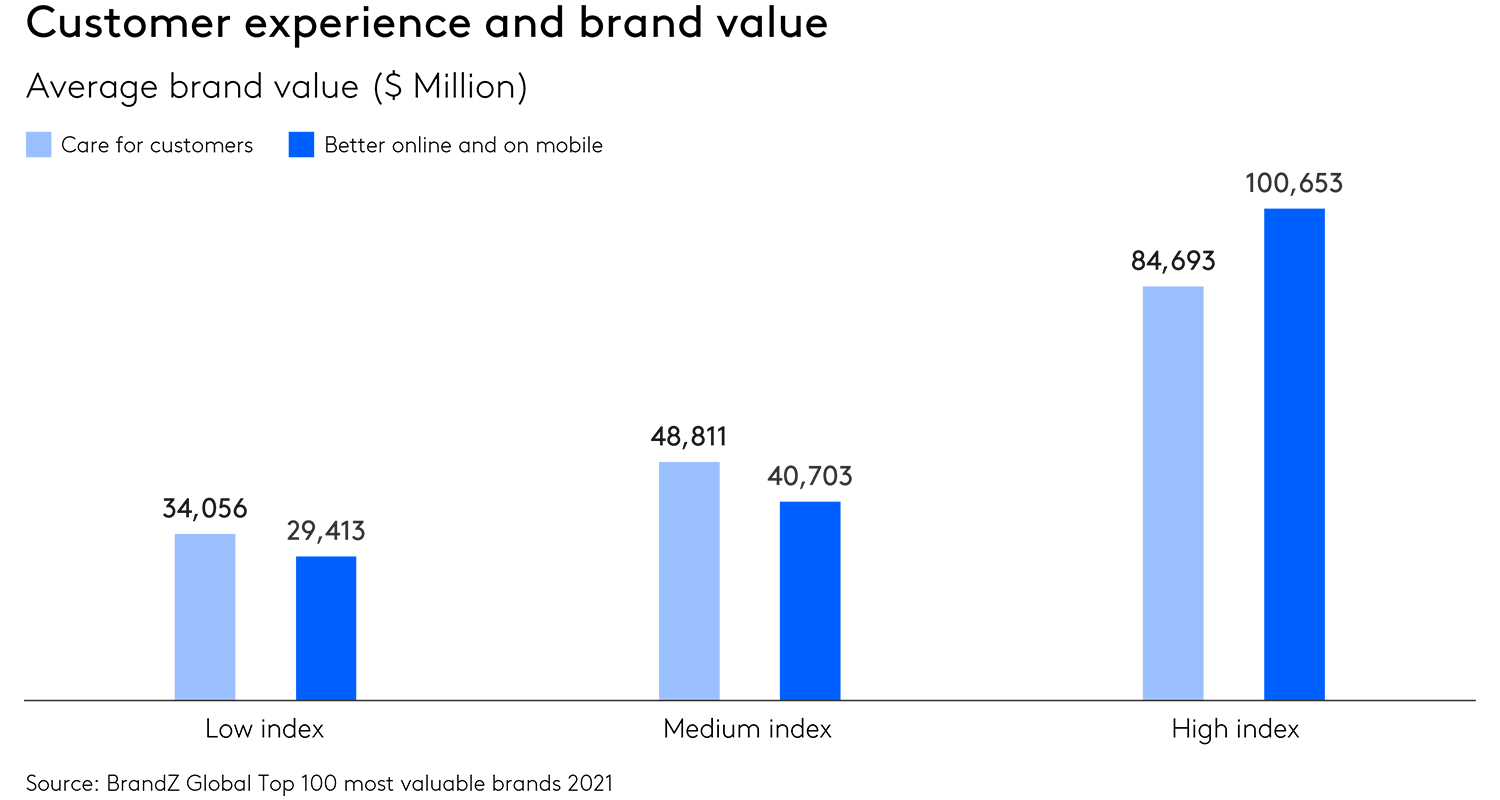Kantar BrandZ highlights the importance of customer experience. Brands with strong customer experience grow brand value at a much higher rate than brands with low customer experience.
Brands delivering a strong customer experience are more valuable

Most brand interactions leave a lasting impression on people, and the success of a brand is defined as much by its customer experience (CX) as it is by products and services. Kantar studies repeatedly show the importance of customer experience in driving brand differentiation and how closing the gap between CX and brand promise can supercharge growth.
Our Connect database also shows that up to 75% of brand-building comes from experiential touchpoints. Delivering a consistently great customer experience (CX) is no longer optional.
So, what do the CX community and CX practitioners need to do?
A new chapter
Do we need a new chapter in marketing textbooks about customer experience, or do we need an entire book on it? This question bothers me every time I come across a ’marketing’ article about the 4Ps (or sometimes more Ps), brand funnels, purchase cycles, and decision-journey concepts.
These articles talk about pre-purchase and post-purchase in new funnels and journeys, but rarely talk about the concept of experience. This is an interesting omission since it is the experience at each stage of the journey or funnel that actually determines brand success –pre-purchase experience, purchase experience and post-purchase experience. This is true whether we talk about service sectors like banking, telecommunications, retail or airlines, or consumer packaged goods and e-commerce brands.
I did my MBA many, many years ago, and esteemed marketing professor Philip Kotler, the father of modern marketing, and others of that era were not really talking about the relationship between brand and customer experience at all if memory serves me right.
So, I did a review of current marketing textbooks to check whether things had changed. A quick read revealed that:
- The concept of brand experience and the importance of experience is covered in greater detail. There are examples of successful brands that have been built on delivering great experiences.
- But Customer Experience (CX) is not really identified as a discipline in its own right.
Modern marketing
CX should be given its proper place in marketing and business; not just as a chapter in a book, but a book of its own, given the huge contribution it makes to business success.
Organizations need to confront some big questions when it comes to customer experience: What is the role of CX in my business? How is CX structured and governed? How does it work across the organization?
In all fairness, CX as a concept and a discipline is relatively new. CX needs to be understood correctly (that is, not confused with customer care or the complaints department), and CX concepts need to be implemented in tandem with marketing functions; you can’t have a gap between brand promise and customer experience.
Brands like IKEA, Starbucks and Apple are good examples of brands that have a clear brand promise, and their delivered experience is aligned with their brand promise. All these brands have strong brand equity and high customer experience.
The Customer Experience Professionals Association (CXPA) has done a good job of encouraging businesses and CX professionals to think more deeply about CX and has highlighted customer-centric CX disciplines.
Four principles for successful CX
Based on our experience at Kantar, these are the broad pillars that brands need to get right:
1. Align vision, mission, brand strategy and CX strategy
The first step is to build from the brand vision, mission and strategy – and create a CX strategy that is aligned with these aspects. The CX strategy then needs to translate into tangible actions – CX values, how these reflect across all journeys, touchpoints and all interactions, in the way staff behave and interact with customers.
2. Develop a CX strategy to create memorable experiences
Brands need to build winning customer relationships by clearly defining their strategy and the experience they want to provide. To build a compelling CX strategy it is important to hear from customers directly about their CX needs and expectations, understand where your brand stands relative to the competition and if your brand is truly differentiated on CX.
3. Measure, monitor and improve customer experiences
There are many sources for getting customer feedback and acting on it - solicited and unsolicited, structured and unstructured, information from digital platforms, call centers and much more. It is important to capture feedback at a total relationship level and also across journeys and touchpoints to engage customers and create memorable experiences. An ROI focus will help build the case for more investment in Customer Experience.
4. Activate customer-centricity throughout the entire organization
Customer-centricity is not the responsibility of a department. It needs to be embraced by everyone in the organization – across different functions e.g., CX, Marketing, Digital, IT, HR and Finance; be it front-line staff or enablers. Brands also need to empower employees to respond and act on customer feedback. Based on the feedback, you can involve cross-functional teams as appropriate to develop short and long-term action plans and develop solutions that create memorable customer experiences.
Art and science
To sum up, CX is both a science and an art. It is multi-disciplinary, calling for expertise in strategy, design thinking, behavioral economics, change management, innovation, employee experience, insights, and business orientation. It is both strategic and operational; considering the number of journeys and touchpoints a brand needs to get right 24/7, 365 days a year.
CX truly cuts across the entire organization; every department and function has an important role to play. It needs a huge organizational focus – and CX professionals who think and act differently.
To bring that about, we need to change the way that people in our industry learn about CX. Yes, that means changing the textbooks, and changing organizations so that they truly appreciate CX and what great CX can achieve. The brands that stand out in the Kantar BrandZ ranking embrace CX as a philosophy and culture that permeates the entire organization.


